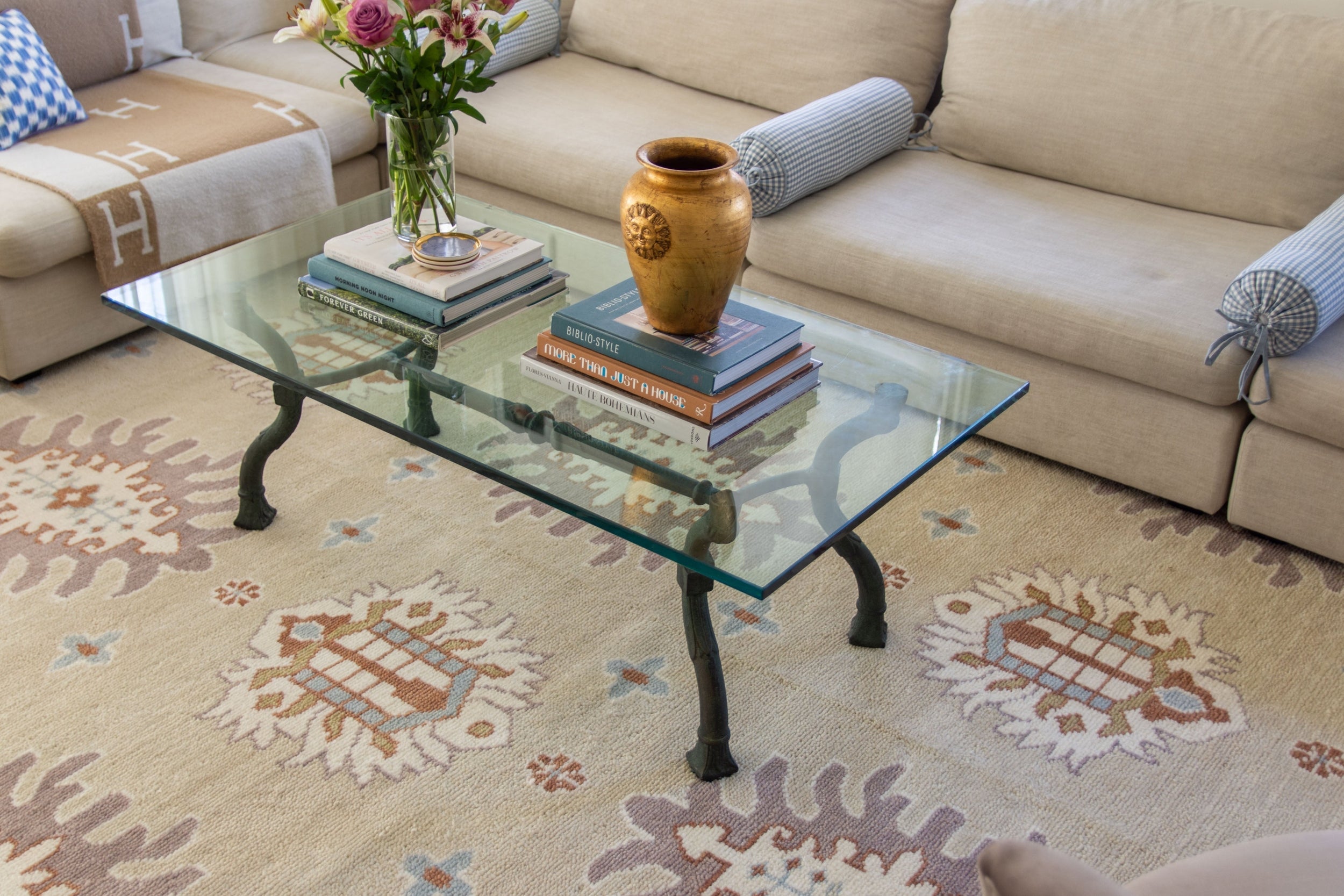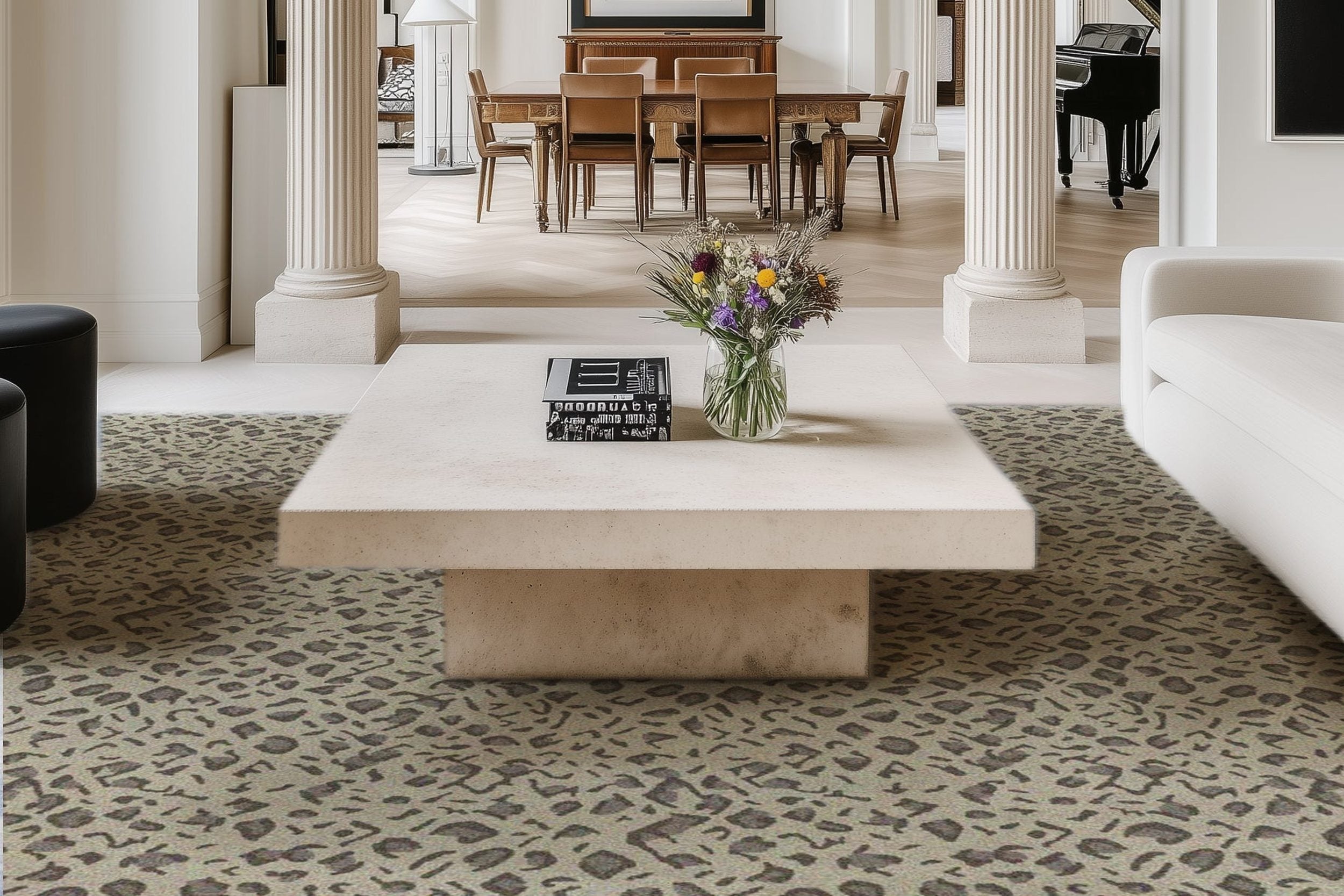DIY Guide to Making a Luxury Rug
 Define “Luxury” So You Don’t Miss What Matters Later
Define “Luxury” So You Don’t Miss What Matters Later
Imagine stepping out of bed on a winter morning - your toes searching for warmth, your ears tuned to the way sound softens when something plush covers the floor.
That’s luxury.
Not a showroom photo-op, not a staged Pinterest square, but the real, lived-in comfort you notice on day two, day two hundred, and year seven.
So, what actually matters?
How the rug feels underfoot, how it ages with your life, and how it reads in your particular light.
You’ll need to decide: cushion, warmth, sheen level, traffic tolerance, cleaning reality, and yes, budget. Don’t roll your eyes at the budget bit - it isn’t just a cap, it’s a compass.
Luxury doesn’t mean reckless spending; it means placing money where it stays visible. Tie every choice to the room’s purpose: a barefoot sanctuary, a lively family hub, or that formal hosting zone where shoes clack and wine occasionally tips over.
Luxury lives at the intersection of hand-feel, visual depth, and durability.
Miss one and you’ll notice every single day.
- Decide first: underfoot softness target, temperature, and acoustic dampening.
- Softness, quantified: go beyond the squeeze test in the shop. You want a face weight ≥ 2,400 g/m² for plush living rooms; check for compression set recovery ≥ 70% after 24 hours - translation: will it spring back or look like it’s sulking after a sofa leg sits on it?
- Warmth: on stone or LVT, aim for pad tog 1.0-1.5; wool pile (thermal conductivity ~0.04 W/mK) is nature’s radiator. Imagine the floor of a Roman bathhouse warmed by a hypocaust, except this time it’s under your toes.
- Noise: don’t underestimate sound. A felt pad that delivers ∆Lw ≥ 18 dB impact sound reduction means conversations sound like Oxford’s Bodleian library reading room instead of a school gym.
- Name constraints: pets, food zones, toys, chair casters, and sunlight angle.
- Pets? Skip the shag. Go with a tight-twist wool/nylon blend (≥ 4.5 TPI twist). Long loops are essentially free tickets for claws.
- Dining table? High contrast patterns look stunning in Architectural Digest spreads, but one dinner party later, you’ll see every crumb. Choose low-contrast heather instead.
- Sunlight blasting through south-facing windows? That lovely sheen will bleach faster than paper left in Shakespeare’s Stratford birthplace gift shop. Go with solution-dyed fibers (Blue Wool Scale ≥ 7).
- State lifespan goal: 7-10 years for living rooms, 3-5 for kitchens, heirloom status if you’re aiming for hand-knotted.
- Want 7-10 years? Schedule professional cleans every 18-24 months. Think of it like sending your rug to a spa retreat before it burns out.
- Going heirloom? Only a hand-knotted 120-200 KPSI wool warp/weft earns that title. Keep a care ledger - cleaning dates, spot treatments - just as libraries catalogue rare manuscripts.
Mini-summary - Core Intent: Define feel + lifespan now; retrofitting later costs far more.
 Tools That Deliver Pro-Level Results
Tools That Deliver Pro-Level Results
This is your printing press. Use cheap tools and you’ll feel it every cut.
- Shears: 250-300 mm blades, 400-500 g. Hollow-ground, micro-serrated for grip.
- Tufting gun: 5-45 stitches/sec, needle diameter 3-5 mm. Stock spares.
- Napping brush: 36-48 pins/10 cm.
- Roller: 30-45 kg, diameter 150-200 mm.
- Hole punch: parallel-action jaws, HRC 57 case hardened jaws (we like Maun's heavy duty punch tool for this)
Cutting, Seaming, And Binding Without Amateur Edges
Edges announce craftsmanship. Sloppy cuts read like typos in the first line of a book.
- Cutting: backface up, hooked blade 0.5-0.7 mm kerf. Score, don’t saw.
- Seams: seam width ≤ 1.5 mm. Butt joints, latex edge seal. Roller 30-45 kg once cooled.
- Binding: cotton, linen, or leather tape. 25-30 mm width, 4-6 stitches/cm. Mitered corners stitched at 45°. Tape tension consistent - too loose and it gapes, too tight and it puckers.
- Fringe: if knotted, hand-overcast 8-10 stitches/inch. Pre-shrink fringe yarns.
Mini-summary - Edge Standard: Treat cuts like typography - crisp, aligned, invisible.
 Choose A Build Method That Matches Your Vision
Choose A Build Method That Matches Your Vision
Every construction method is like a different publishing house: some crank out predictable bestsellers, others produce rare folios. What kind of story do you want your rug to tell?
- Hand-tufted: fast, dense, sculptable; latex-backed; mid budget; good for curves and carved motifs (source).
- Primary cloth: polyester monk’s cloth, 200-260 gsm; without it, tufts slip like loose type in a broken printing press.
- Gauge & stitch: 6-10 stitches/inch for mid-plush. Higher count, sharper text, like typesetting at Faber & Faber.
- Latex: low-VOC SBR, spread 1.5-2.0 mm wet, embed scrim, cure 24-48 h at 20-25 °C. Yes, it smells, but without it the rug is a stack of loose papers.
- Repair path: re-tuft bald spots; re-latex delaminations.
- Hand-knotted: heirloom strength, crisp pattern, graceful aging. Think of it as letterpress: slow, costly, but every knot a character.
- Counts: 90 KPSI gives readable “text”; 150+ KPSI makes it fine print; Persian Qom can exceed 400 KPSI.
- Structure: wool pile, cotton warp/weft; pick symmetrical (Turkish) knots for heavy traffic.
- Repair path: re-knot, back-stitch. It’s conservation work, closer to restoring a vellum manuscript than fixing a paperback.
- Flatweave (kilim, soumak): reversible, light, easy to move, less plush.
- Kilim slit weave: bold graphics, vertical slits under 30 mm prevent curling. Reinforce with ladder stitches like mending a rare folio’s binding.
- Soumak: over-under wrapping creates corded relief, 4-6 mm thick. Runners with grip, built like braided margins.
- Machine-woven: consistent, broad widths, fewer yarn choices.
- Axminster: individual yarn feed, like offset printing for complexity.
- Wilton: loop or cut/loop; economical but less flexible.
- Pile weight: 1,200-2,000 g/m² - sufficient for utilitarian dining (source).
- Hand-sewn collage: stitched panels, leather appliqué, felted edges. Think of this as the indie press chapbook - every imperfection a feature.
- Adhesives: solvent-free contact.
- Seam allowance: 20-25 mm, boards weighted at 5-8 kg. Grade seams to avoid bumps underfoot.
Mini-summary - Build Reality: Technique dictates texture, repair path, and price.
 Select Fibers for Hand, Sheen, And Workload
Select Fibers for Hand, Sheen, And Workload
Fibers are the ink. They set the tone, longevity, and even mood.
- Wool (New Zealand, high-twist): the Oxford University Press of fibers - reliable, timeless. Micron 28-32 μm, twist ≥ 4 TPI. Moisture regain 14-16%, static-resistant, mothproof with Eulan SPA.
- Silk / Viscose / Lyocell: luminous, cool hand. Silk tensile strength ~0.6 GPa. Viscose moisture regain 11-13% (too absorbent). Limit cellulose to ≤ 30%.
- Nylon 6,6: abrasion resistance > 20,000 Martindale rubs; solution-dyed, UV lightfastness ≥ 7. If wool is a Penguin Classic, nylon is a glossy hardback that survives coffee stains.
- Linen: crisp matte; tensile strength ~5.5 g/den; blend as binder.
- Mohair / Alpaca: haloed, airy hand; diameter 23-30 μm. Singe or clip the halo to 1-2 mm. Bedroom or low-traffic, not front-hall chaos.
- Recycled PET: density ~1.38 g/cm³, melting point ~255 °C. Firm feel, safe for radiant heating, waterproof - think of it as the paperback you can read on the beach.
Mini-summary - Fiber Fit: Match yarn physics to traffic, light, and cleaning plan.
 Dial Pile Height, Density, And Cushion For “Ahh” Without Trips
Dial Pile Height, Density, And Cushion For “Ahh” Without Trips
Softness isn’t just tall pile. It’s an orchestration (source).
- Pile height targets: 8-10 mm living rooms, 12-16 mm lounges, ≤6 mm dining. Taller? Needs face weight ≥ 3,000 g/m² or it flops.
- Density: SPI 8-10 tufted, KPSI 120-160 knotted. Tufts per dm² ≥ 200. Without density, patterns blur like cheap photocopies.
- Underlay: felt 9-12 mm (density ≥ 110 kg/m³), COF ≥ 0.5. Doors must clear 15-22 mm total. Imagine dragging a door across a rug that resists like a stubborn Oxford don - avoid it.
Mini-summary - Plush Control: Combine modest height with firm density and quality felt to get softness plus stability.
 Cut To Room Proportions That Anchor, Not Float
Cut To Room Proportions That Anchor, Not Float
Nothing looks worse than a rug floating like an undersized postage stamp on a parquet envelope.
- Living seating: front legs on pile, 20-30 cm wall gap, walkways ≥ 90 cm.
- Dining: extend 60-70 cm beyond the table; for round tables, use the diameter + 120-140 cm.
- Bedroom: queen 240×320 cm, king 270×360 cm, runners 70-90 cm wide.
- Hall: 10-15 cm reveal both sides; width 75-90 cm for 100-120 cm halls.
Mini-summary - Scale That Works: Dimensions follow furniture footprints, not wall lines.
 Design A Pattern You Won’t Regret
Design A Pattern You Won’t Regret
Patterns are literature for the floor - choose wisely or you’ll be stuck with pulp fiction.
- Repeat size: 40-80 cm motifs for large rooms, micro-pattern for small. Ensure drift ≤ 3 mm at seams.
- Visual texture: heather blends hide lint; ∆L ≤ 5 across shades keeps it subtle.
- Borders: inner offset 6-8 cm; binding width 25-30 mm. Avoid heavy borders in tight rooms - they’re like footnotes swallowing the text.
- Color mapping: yarn codes per zone, 3-5 families max. Tip-shear depth 1-2 mm for highlights.
Mini-summary - Pattern Discipline: Choose a repeat that fits sightlines; sample at 1:1 where possible.
 Backing That Locks Structure for Years
Backing That Locks Structure for Years
Backing is your typeset lockup - it keeps lines aligned.
- Primary: tufted cloth.
- Scrim: woven polyester 150-200 gsm.
- Adhesive: SBR latex, 1.5-2.0 mm cured. Cure under airflow, 20-25 °C.
- Secondary: jute or synthetic, 180-250 gsm.
- Anti-slip: rubberized spray or felt underlay.
Mini-summary - Back Security: Multi-layer prevents slip, curl, or delam.
Cleaning Strategy That Protects Investment
Skip strategy, and you’ll watch your rug age like an unjacketed paperback left in the rain.
- Routine: vacuum 2× weekly, suction only. Beat outside 1-2× yearly.
- Spots: blot, don’t rub. Wool-safe neutral detergent, pH 5.5-7.
- Professional: hot water extraction ≤ 60 °C or dry compound. Frequency: 18-24 months.
- Rotation: every 12-18 months. Even exposure prevents fading and traffic marks.
- Sunlight: UV-filter window film, curtains, or rotate. UV light causes ∆E > 5 in 6-12 months without protection.
Mini-summary - Care Map: Prevent irreversible damage with rotation, mild chemistry, and proper servicing.
Storyboard Your Rug Like an Editor Prepares a Manuscript
Luxury rugs don’t appear fully formed; they’re drafted, tested, and edited. Storyboarding makes the difference between “good idea” and “forever proud.”
- Moodboard: collect yarn wraps, sketches, fabric scraps. Pin 30-40 elements. Cull to 10-12.
- Mock-up: 1:10 painted grid, yarn-wrapped card. Place in situ, photograph under three light sources.
- Scale swatch: 30×30 cm tuft or weave. Live with it for a week. Watch morning and evening.
- Adjustment: record changes; never trust memory.
- Final order sheet: fiber codes, stitch counts, dimensions, colors, backing. Triple-check. Keep a copy on file.
Mini-summary - Draft Then Commit: Preview through swatches and mocks to lock confidence before full build.
Browse by Category

Design Projects
Explore interiors from client work and personal renovations — layered, livable, and always in progress.
read more →
Collaborations
From product launches to styled spaces, discover the brand stories I’ve helped bring to life.
read more →
The Notebook
A growing archive of iconic designers, inspiring artists, and unforgettable design moments.
read more →
Travel by Design
Wander with a designer’s eye — from charming hotels and city guides to visual inspiration abroad.
read more →




